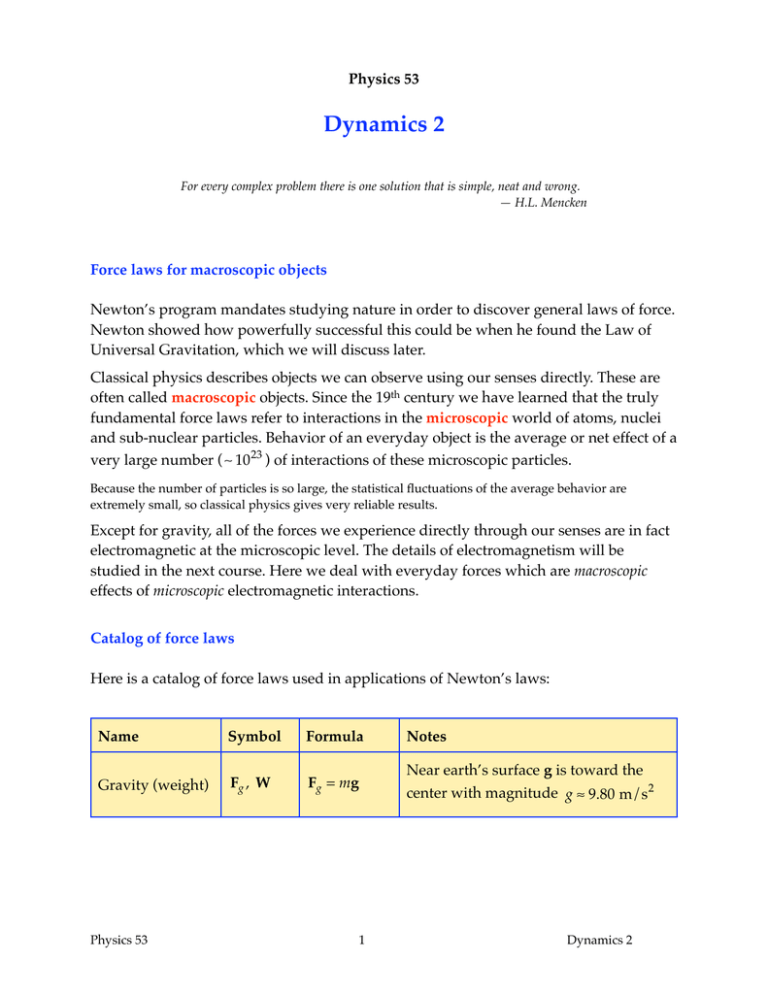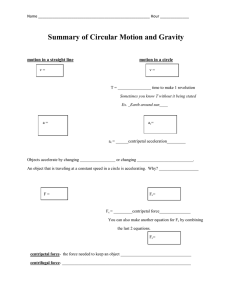Dynamics 2
advertisement

Physics 53 Dynamics 2 For every complex problem there is one solution that is simple, neat and wrong. — H.L. Mencken Force laws for macroscopic objects Newton’s program mandates studying nature in order to discover general laws of force. Newton showed how powerfully successful this could be when he found the Law of Universal Gravitation, which we will discuss later. Classical physics describes objects we can observe using our senses directly. These are often called macroscopic objects. Since the 19th century we have learned that the truly fundamental force laws refer to interactions in the microscopic world of atoms, nuclei and sub-nuclear particles. Behavior of an everyday object is the average or net effect of a very large number ( 10 23 ) of interactions of these microscopic particles. Because the number of particles is so large, the statistical fluctuations of the average behavior are extremely small, so classical physics gives very reliable results. Except for gravity, all of the forces we experience directly through our senses are in fact electromagnetic at the microscopic level. The details of electromagnetism will be studied in the next course. Here we deal with everyday forces which are macroscopic effects of microscopic electromagnetic interactions. Catalog of force laws Here is a catalog of force laws used in applications of Newton’s laws: Name Symbol Formula Notes Gravity (weight) Fg , W Fg = mg Near earth’s surface g is toward the center with magnitude g ≈ 9.80 m/s2 Physics 53 1 Dynamics 2 Normal force Tension Compression Elastic force FN , N FT , T FN , N Fk — This is a repulsion between atoms at the interface between two objects, to prevent interpenetration. It is normal (perpendicular) to the interface surface. In our applications its strength is as much as needed, and deformation of the surfaces is neglected. — A “pull” on an object attached to the end of a string or rod. It is away from the end and toward the center of the string or rod. The strength is as much as needed, up to the point of breaking or significant deformation. — A “push” exerted by a solid object, basically like a normal force. The direction is away from the center of the solid object. Normal forces, tensions and compressions do not act at a single point, but are distributed over the contact surface, in the form of stresses. Fk = −kx Hooke's law. Applies approximately to springs and other elastic systems. Here k is the “stiffness” constant and x is the amount of deformation. The negative sign shows that the force exerted by an elastic system is directed opposite to its deformation. Acts between surfaces to prevent sliding, when sliding is not actually occurring. Here µs is the coefficient of Static friction Physics 53 fs fs ≤ µs N 2 static friction (usually less than 1) and N is the magnitude of the normal force at the interface. The direction is along the interface, opposite to the direction in which sliding would occur if there were no friction. Its magnitude can be anything from zero to the limit given. Dynamics 2 Acts when sliding does occur. Here µ k Kinetic friction fk fk = µk N is the coefficient of kinetic friction ( < µs ). The direction is along the interface, opposite to the direction of sliding. Forces in circular motion In our discussion of circular motion we found that there must be a radial acceleration toward the center of the circle, of magnitude exactly v 2 /R , where v is the particle's speed and R is the radius of the circular trajectory. By the 2nd law, there must be a net force to provide this acceleration. We call this the radial force. It can arise from any of the types listed in the catalog above, or a combination of them. In textbooks the radial force is sometimes called the “centripetal” force, because it produces the “centripetal” acceleration. We avoid these obsolete terms, because students tend to think “centripetal” denotes a new kind of force law, which it does not. The name, radial or centripetal, describes what the force does, rather than what kind of force it is. If a particle of mass m is moving with speed v in a circle of radius R, then there must be a radial component of the total force toward the center of the circle, given exactly by Fr = mar , where ar = mv 2 /R = mRω 2 Radial force If the radial component of the actual total force is larger or smaller than mv2/R, the particle will not follow a circle of radius R at speed v, but some other trajectory. The total force may also have a component tangent to the circle, which will give rise to a tangential acceleration, changing the particle's speed. What expression appears on the left side of this equation depends on what kind of force is providing the radial acceleration. It can be any of the ones listed in the table above. Non-inertial frames Newton's laws of motion apply as given so far only in inertial reference frames. It is always possible to use such frames for the analysis of a situation, but often it is more intuitive to use a reference frame that is accelerating. For example, to describe the motion of an object sliding across the seat of an auto going rapidly around a curve, one can use an inertial frame fixed on the ground, but it is often more intuitive to use a (non-inertial) Physics 53 3 Dynamics 2 frame fixed in the auto. Fortunately it is possible to use non-inertial frames in applying Newton’s laws, with only a modest modification of the forces. In the earlier discussion of reference frames we found the formula for the acceleration of an object (P) as seen by two observers (A and B) in motion relative to each other: a P/A = a P/B + aB/A . Let A be in an inertial frame and let B’s frame be accelerating. Then by the 2nd law, in A’s frame Ftot = ma P/A . Here Ftot is the sum of the interaction forces exerted on P by its environment. These will be the same in B's frame, but the observed acceleration will be different, so the 2nd law will not hold in that frame. However, let us solve for ma in B's frame: ma P/B = m(a P/A − aB/A ) = Ftot − maB/A . This shows that if we add to the interaction forces the quantity −maB/A then we get an “effective total force” which does obey the 2nd law in B's frame. The quantity −maB/A is called an inertial force. It arises entirely from the acceleration of B’s frame. Because they are artifacts of the use of a non-inertial frame, inertial forces are sometimes called “fictitious forces” or “pseudoforces”. The distinction between “real” and “fictitious” is not so clear, however. To introduce the inertial force is not just a trick. How does B determine experimentally what the total force on P is? By measuring the acceleration and using the 2nd law. To B the total force is the right side of the equation above, including the term −maB/A . To B the inertial force is quite real and observable. There are numerous examples where it is useful to view things from an accelerating frame, and in which inertial forces play an important role. Consider, for example, a reference frame fixed at a point on the earth’s surface, e.g., in an ordinary laboratory. Such a reference frame rotates daily about the earth's axis and revolves annually about the sun; both of these motions involve acceleration, so this is not an inertial frame. Because the accelerations involved are quite small, we often assume such a frame fixed to the earth to be inertial as a good approximation. It would be very cumbersome to describe phenomena taking place on the earth from the point of view of some imaginary inertial frame at rest relative to the sun — or to the center of the galaxy, or whatever. So we generally employ a non-inertial frame fixed on the earth’s surface. Among the resulting inertial forces we might have to take into account in very accurate work on the earth’s surface are the centrifugal force, tending to Physics 53 4 Dynamics 2 push objects away from the rotation axis of the earth, and the Coriolis force, acting at right angles to the velocity of a particle moving relative to the rotating reference frame. It is the Coriolis force that makes winds circulate clockwise around a high pressure area in the northern hemisphere, and the other way in the southern hemisphere. In meteorology it is very real indeed. Because inertial forces are proportional to the mass of the object, they can be combined with gravity (also proportional to the mass) to form an “effective” gravity. We separate gravity from the other forces acting on the particle and write Ftot = Fnon− grav + mg . Then the total force in B's frame (including the inertial force) will Be Ftot (in B's frame) = Fnon− grav + m(g − aB/A ) . We define the quantity in ( ) on the right to be the effective acceleration of gravity in B’s frame. Using the simpler notation a0 to represent the acceleration of B’s frame relative to the (inertial) frame of A, we have a simple and very useful formula: g eff = g − a0 Effective gravity This formula is a vector equation. This means that g eff can differ from g in direction as well as magnitude. Some important aspects of effective gravity: • The measured weight of an object is mg eff . This is often somewhat disparagingly called “apparent” weight; but it is the actual weight one finds by any valid measurement, such as by use of any kind of scale or balance. • In a non-inertial frame, an object dropped from rest will fall in the direction of geff , which therefore gives the direction of “down” in that frame. • An object in “free fall” (on which the only force acting is gravity) will have acceleration g, so in a reference frame moving along with the object geff = 0 . Anything at rest in such a frame will have zero measured weight. Astronauts in orbit around the earth provide a well-known example of this “weightlessness.” We will make use of geff in our discussion later of tides caused by the moon and sun. Physics 53 5 Dynamics 2

